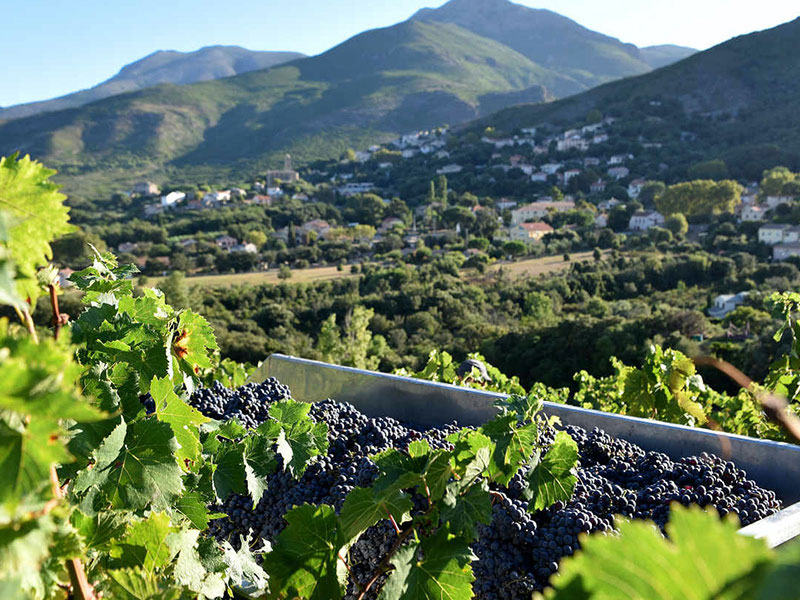
Corsican cold cuts
THE ORIGINS OF CORSICAN COLD CUTS
Corsican cold cuts are an integral part of the island's gastronomic heritage. La Méridionale invites you to head off and discover gourmet Corsica, a blend of incomparable flavours, only found on the Island of Beauty.
Composition of Corsican cold cuts
Authentic Corsican cold cuts are made from "Nustrale" pigs, bred in semi-liberty.
This species of island pig lives at the heart of the forests and maquis and feeds on grasses, chestnuts, worms, fern roots, etc. (in addition to the feed provided by the breeder).
In the autumn time, "porcu nustrale" eat acorns and chestnuts exclusively. By doing so, they store quality fat that gives Corsican cold cuts all its flavour.

Preparing Corsican cold cuts
Over winter, breeders prepare their cold cuts and their spice mix, then they salt them, flavour them, smoke them with chestnut wood, dry them and, lastly, leave them to mature.
CDO (AOC) to protect the Corsican gastronomic heritage
Given a high level of fraud and an upsurge in counterfeit products labelled "charcuterie corse" (Corsican cold cuts), traditional breeders got together in 2012 to create a label to certify the authenticity of the products sold. This Controlled Designation of Origin (AOC in French) concerns 3 iconic products from Corsica:
- "Prisuttu" or "Corsican cured ham"
- "Coppa di Corsica" or "Corsican Coppa"
- "Lonzu" or "Corsican Lonzo"
The "Salameria Corsa" logo is stamped on these regional products so you can recognize them easily.
THE DIFFERENT TYPES OF CORSICAN COLD CUTS
Although only 3 Corsican cold cuts are protected by the CDO (AOC) label, there are others that are just as delicious. Let's take a look at the star Corsican cold cuts.
"Prisuttu" or "Corsican cured ham"
Prisuttu is made from "Nustrale" pork leg.
It's an exceptional ham with an elongated shape and a hazelnut taste. It's firm yet rich and you can buy it whole on the bone, in portions or sliced. Prisuttu takes 4 months to mature and can be eaten all year long.
You can also enjoy eating the fat from this cured ham as that's what gives it its particular flavour.

"Coppa di Corsica" or "Corsican Coppa"
Corsican Coppa is made from "Nustrale" pork shoulder. These round slices should be cut very fine so they diffuse their aromas of hazelnut and butter with a slightly smoky taste. This Coppa is soft and rich and features a bright red colour interspersed with fat. It takes 2 months to mature and Corsican Coppa can be eaten from spring through to summer. You can store it, its flavours will be even more pronounced.
"Lonzu" or "Corsican Lonzo"
Lonzu is made from "Nustrale" pork loin. It's easily recognizable with its slice of covering fat that takes up ⅓ of a slice. What's more, it's the fat that gives Corsican Lonzo its characteristic smoked buttery-hazelnut flavour. It needs 1 month to mature to be tasted as of springtime. It can also be stored to enhance its taste even more.


"Panzetta" or "Pancetta"
Panzetta is made from "Nustrale" pork belly. It is either rolled or flat and its meat is rich with hints of maquis herb and chestnut notes that alternate with the layers of meat and fat, a bit like lard. Corsican Pancetta can be eaten all year round, for aperitifs as well as in Corsican recipes where it has become a must-include.
"Salsiccia" or "Corsican saucisson"
Salsiccia is made from "Nustrale" pork shoulder. A variation also exists made from wild boar. It has a slightly peppery taste and its firmness depends on how long it has been dried for, generally a minimum of 5 weeks in winter. In a nutshell, your Corsican saucisson will be dry in summer as it will have dried over the winter, so if you come across tender ones in the summer, don't buy them. Be careful if you see donkey saucisson as this is not one of Corsica's regional products.
"Figatellu" or "Figatelli"
Figatellu is made from "Nustrale" pork liver, meat, lean and fat. It diffuses spicy, garlic and wine notes. Although other parts of offal may be included in its composition, Corse-du-Sud Figatellu is stronger on the palate than the one from Haute-Corse as it contains more liver. Its U shape makes it stand out from the others. Fresh Figatellu is eaten grilled in winter, around 10 days after it's produced. Dry Figatellu can be eaten all year round for an aperitif.
HOW TO ENJOY YOUR CORSICAN COLD CUTS
To bring out the different flavours of your Corsican cold cuts, you'll need a good wine, CDO (AOP) cheese and other local Corsican products.
Which wine should you pair with your Corsican cold cuts
We recommend you visit Haute-Corse, and more specifically the Patrimonio vineyard that stretches over 7 municipalities. Here, you'll discover a wine that boasts the oldest CDO (AOC) in Corsica. The combination of limestone soils and carefully-selected varieties of grape produces white, red and rosé wines that will enchant your palate and will perfectly accompany your platter of Corsican cold cuts.
A Coteaux du Cap-Corse, a Controlled Designation of Origin wine also referred to as "Vin de Corse", will pair wonderfully well with Lonzo, Coppa as well as Corsican dry ham.
A Sartène wine, from Southern Corsica and CDO (AOC) since 1976, will delight your taste buds and will exalt your Corsican cold cuts.





